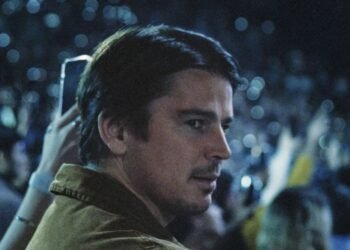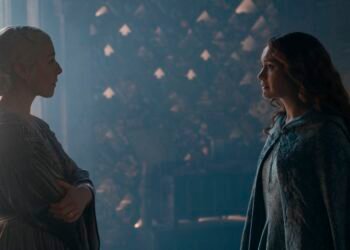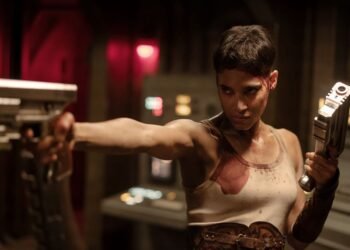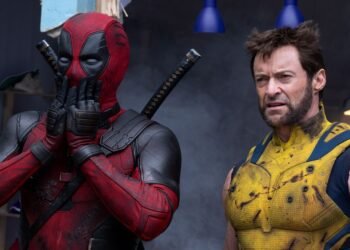[Ed. note: This review of Ghostbusters: Afterlife originally ran in conjunction with the film’s early screening at the 2021 New York Comic Con. It has been updated for the theatrical release.]
After more than a year of pandemic-related scheduling delays, Ghostbusters: Afterlife finally made it to theaters. The newest movie in the franchise is a direct sequel to Ghostbusters 2, which was released more than 30 years ago. Its director and co-writer, Jason Reitman, is the son of Ivan Reitman, who directed both the original 1984 Ghostbusters and its 1989 sequel. Like so many other franchises these days, the new movie concentrates on handing over a familiar property to newer, younger characters. But it also acknowledges the nostalgia that longtime fans may feel for the original story — sometimes at the expense of the new story Reitman is telling.
Ghostbusters: Afterlife follows Callie (The Leftovers’ Carrie Coon) and her children Trevor (Stranger Things’ Finn Wolfhard), and Phoebe (Mckenna Grace), as they move from their life in the city to a broken-down farmhouse in the middle of nowhere, which Callie’s estranged father owned and died in. As it turns out, her father also happened to be Egon Spengler, the former Ghostbuster originally played by Harold Ramis. The movie overall is a touching tribute to Ramis, the co-writer and co-star of the original films, who passed away in 2014.
Inside the house, Egon left seemingly hundreds of tools, gadgets, and Ghostbusting paraphernalia for Phoebe and Trevor to discover, and for longtime fans to cheer over. These moments of nostalgia are littered all over the place, and the references are mostly harmless fan service — even if it occasionally feels like the camera lingers too long on a prop or two from the original movie. The one real exception is a cloying moment near the end of the movie that sends it hurtling over the nostalgia cliff, and sours the whole experience a bit.

Photo: Sony Pictures
Unlike other recent long-delayed sequels, like Star Wars: The Force Awakens, Afterlife sidesteps the worst nostalgia traps by making children its primary characters. Trevor and Phoebe don’t idolize the Ghostbusters — they’ve barely even heard of them, which leaves the enthusiasm for the fans in the theater, rather forcing it out of the actors on screen.
The most commendable part of Afterlife may be its structure, and how little it looks like the original Ghostbusters, even though the movies’ stories share more than a few similarities. There’s no attempt to form a new Ghostbusting team, or to recapture the magic and chemistry of the original stars. Instead, Reitman focuses on building strong characters — something he excelled at in his previous movies, like Up in the Air and Juno — and bringing them into the Ghostbusters world. Rather than a work of pure reinvention, Afterlife feels more like an expansion of the universe, and of the limits defining what a Ghostbusters movie can be. This movie says a Ghostbusters story can be about kids finding where they fit into the world, just as much as it can be about Bill Murray flirting with Sigourney Weaver after she’s turned into the herald of a Sumerian god.
Those kids are really the stars of this show. Rather than a witty one-liner comedy like the first two movies, Ghostbusters: Afterlife is more like an Amblin Entertainment movie, full of adolescent adventures and a few jokes along the way. There are sweeping scenes of kids getting into trouble, and discovering first crushes and first friends. Adults like Paul Rudd, playing a science teacher named Gary Gruberson, show up to offer the kids some help, or at least some funny exposition.

Image: Columbia Pictures
The performances by the movie’s young actors are mostly winning, but the two standouts by far are Mckenna Grace’s Phoebe and her first-ever friend, who calls himself Podcast because he hosts one. Podcast is played by newcomer Logan Kim, who is hilarious, charming, and a natural-born scene-stealer. But while Kim provides most of the movie’s best jokes, Grace handles just about everything else. If this movie rests on the shoulders of any one character, it’s Phoebe, who is socially awkward, a little weird, and tremendously smart — exactly what Ghostbusters fans would expect from Egon’s granddaughter.
Grace is outstanding in the role, and she echoes Ramis without ever imitating him, making the character uniquely her own. She has to match up with Carrie Coon in the movie’s most dramatic scenes and Rudd in its most comedic, and she’s excellent at each. Grace has already been great in a few movies — including playing the younger version of half the blonde actresses in Hollywood over the last few years — but in Ghostbusters: Afterlife, she may have finally found her star-making role.

Image: Columbia Pictures
Even with its emphasis on its new young characters, Ghostbusters: Afterlife is still stuffed with references, inside jokes, and reverence for the original movies in the series. There are dozens of tiny moments openly designed to make die-hard Ghostbusters fans chee. But the most exciting thing about the movie is how it looks to welcome a new generation of kids into the Ghostbusters world, both onscreen and off. With Afterlife’s endless string of callbacks, Jason Reitman lovingly pays homage to his father’s series, but the new characters are where Jason’s own intimate and personal style of filmmaking shines through. Because of that, it seems fitting that Ghostbusters: Afterlife is at its best when it’s about young characters finding their place in a pop-culture landscape their predecessors built.
Ghostbusters: Afterlife premieres in theaters on Nov. 19.
























































